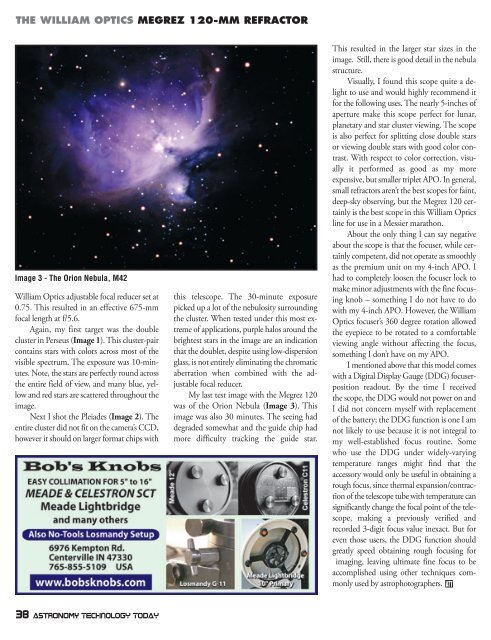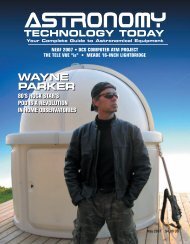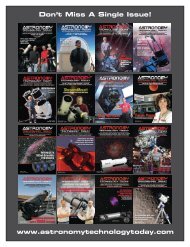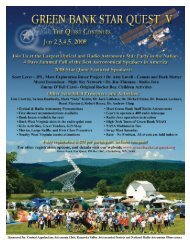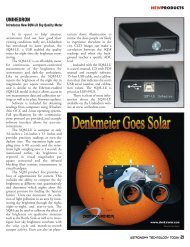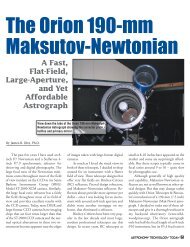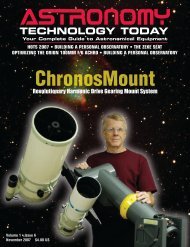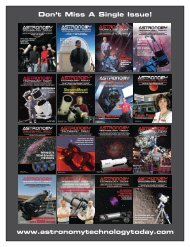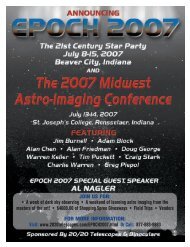magnilux - Astronomy Technology Today
magnilux - Astronomy Technology Today
magnilux - Astronomy Technology Today
You also want an ePaper? Increase the reach of your titles
YUMPU automatically turns print PDFs into web optimized ePapers that Google loves.
THE WILLIAM OPTICS MEGREZ 120-MM REFRACTOR<br />
Image 3 - The Orion Nebula, M42<br />
William Optics adjustable focal reducer set at<br />
0.75. This resulted in an effective 675-mm<br />
focal length at f/5.6.<br />
Again, my first target was the double<br />
cluster in Perseus (Image 1). This cluster-pair<br />
contains stars with colors across most of the<br />
visible spectrum. The exposure was 10-minutes.<br />
Note, the stars are perfectly round across<br />
the entire field of view, and many blue, yellow<br />
and red stars are scattered throughout the<br />
image.<br />
Next I shot the Pleiades (Image 2). The<br />
entire cluster did not fit on the camera’s CCD,<br />
however it should on larger format chips with<br />
this telescope. The 30-minute exposure<br />
picked up a lot of the nebulosity surrounding<br />
the cluster. When tested under this most extreme<br />
of applications, purple halos around the<br />
brightest stars in the image are an indication<br />
that the doublet, despite using low-dispersion<br />
glass, is not entirely eliminating the chromatic<br />
aberration when combined with the adjustable<br />
focal reducer.<br />
My last test image with the Megrez 120<br />
was of the Orion Nebula (Image 3). This<br />
image was also 30 minutes. The seeing had<br />
degraded somewhat and the guide chip had<br />
more difficulty tracking the guide star.<br />
This resulted in the larger star sizes in the<br />
image. Still, there is good detail in the nebula<br />
structure.<br />
Visually, I found this scope quite a delight<br />
to use and would highly recommend it<br />
for the following uses. The nearly 5-inches of<br />
aperture make this scope perfect for lunar,<br />
planetary and star cluster viewing. The scope<br />
is also perfect for splitting close double stars<br />
or viewing double stars with good color contrast.<br />
With respect to color correction, visually<br />
it performed as good as my more<br />
expensive, but smaller triplet APO. In general,<br />
small refractors aren’t the best scopes for faint,<br />
deep-sky observing, but the Megrez 120 certainly<br />
is the best scope in this William Optics<br />
line for use in a Messier marathon.<br />
About the only thing I can say negative<br />
about the scope is that the focuser, while certainly<br />
competent, did not operate as smoothly<br />
as the premium unit on my 4-inch APO. I<br />
had to completely loosen the focuser lock to<br />
make minor adjustments with the fine focusing<br />
knob – something I do not have to do<br />
with my 4-inch APO. However, the William<br />
Optics focuser’s 360 degree rotation allowed<br />
the eyepiece to be rotated to a comfortable<br />
viewing angle without affecting the focus,<br />
something I don’t have on my APO.<br />
I mentioned above that this model comes<br />
with a Digital Display Gauge (DDG) focuserposition<br />
readout. By the time I received<br />
the scope, the DDG would not power on and<br />
I did not concern myself with replacement<br />
of the battery; the DDG function is one I am<br />
not likely to use because it is not integral to<br />
my well-established focus routine. Some<br />
who use the DDG under widely-varying<br />
temperature ranges might find that the<br />
accessory would only be useful in obtaining a<br />
rough focus, since thermal expansion/contraction<br />
of the telescope tube with temperature can<br />
significantly change the focal point of the telescope,<br />
making a previously verified and<br />
recorded 3-digit focus value inexact. But for<br />
even those users, the DDG function should<br />
greatly speed obtaining rough focusing for<br />
imaging, leaving ultimate fine focus to be<br />
accomplished using other techniques commonly<br />
used by astrophotographers.<br />
38 <strong>Astronomy</strong> TECHNOLOGY TODAY


